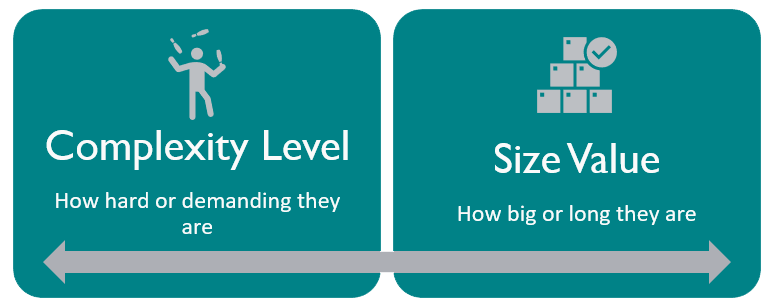Ways in which VET contributes to the TCE is based on TASC’s characterisation of the complexity level and size value in education and training, shown below:

Complexity Level
As explained earlier, for a student to meet the Participation and Achievement Standard, they need 120 credit points of senior secondary education and training (at Level 1, 2, 3 or 4), with at least 80 of those credit points in studies rated at complexity level 2 or higher.
For VET, complexity levels for qualifications, or Units associated with a qualification, align with the Australian Qualifications Framework (AQF):
| Qualification Type | Level | Purpose |
|---|---|---|
| Certificate I | Level 1 | The Certificate I qualifies individuals with basic functional knowledge and skills to undertake work, further learning and community involvement |
| Certificate II | Level 2 | The Certificate II qualifies individuals to undertake mainly routine work and as a pathway to further learning |
| Certificate III | Level 3 | Certificate III Level 3 The Certificate III qualifies individuals who apply a broad range of knowledge and skills in varied contexts to undertake skilled work and as a pathway for further learning |
Students undertaking individual VET Units
For students undertaking individual VET Units that are not part of a full qualification, their successfully completed Units will be recognised at the lowest level of qualification that the Unit is associated with, in the National Register of VET (www.training.gov.au).
Example A:
Student A is doing a discrete VET Unit as part of their senior secondary studies. The Unit, ‘SITXCCS003 – Interact with customers”, is listed on the National Register of VET (www.training.gov.au). The lowest level of qualification that includes this Unit is at a Certificate 1-level. TASC recognises the Unit at Level 1 of complexity for Student A.
Students undertaking full VET qualifications
For students undertaking full VET qualifications, their successfully completed Units will be recognised at the level of that qualification, whether the qualification is completed or not.
Example B:
Student B enrols in a Certificate II in Agriculture. Student B completes most of the Units packaged together with that qualification but gets a job before finishing every Unit in the qualification. Student B is still able to have all the successfully completed Units recognised by TASC at complexity level 2, as all the Units were completed as part of a Certificate II qualification.
For students undertaking a Certificate I qualification, the individual Units associated with the qualification will be recognised at the individual Unit level, if that is higher than the qualification level.
Example C:
Student C completes a Certificate 1 in Hospitality. One of the units packaged together with that qualification, if undertaken on its own, would be recognised by TASC at level 2 complexity (refer above to ‘Students undertaking individual VET Units’). In this instance Student C will have that Unit recognised by TASC at level 2, and the rest of the Units at level 1.
Size Value (Credit Points)
Size value represents a measure of how ‘large’ the learning associated with the VET Unit is. TASC assigns a size value to Units based on nationally agreed nominal hours. On successful completion of a Unit, the size value is converted into TCE credit points.
As a general rule, 10 nominal hours equals 1 credit point.

Nominal hours represent the supervised, structured learning and assessment activities required to sufficiently address the content of each Unit (acknowledging that progress can vary between learners). Nominal hours are assigned to activities that are delivered face-to-face, online, and/or through structured distance education.
Nominal hours are primarily sourced from the National Centre for Vocational Research (NCVER) nationally agreed nominal hours table.
Sometimes VET Units may be nationally recognised, but lack nationally agreed nominal hours. When this happens, TASC uses alternative sources of government data that can be found at:
- Victorian training package purchasing guides
- Skills Tasmania – Training Packages with approved nominal hours
- WA nominal hours guides
To calculate credit points, nominal hours assigned to a Unit are divided by 10 and rounded up from 5, or rounded down from 4. For example:
| Unit Code | Unit Title | Nominal Hours | Credit Points |
|---|---|---|---|
| LMFGG2001C | Use glass and glazing sector hand and power tools | 56 | 6 |
| LMFFT4008A | Interpret and use workplace information | 54 | 5 |
Credit Transfers
A key pillar of the national VET system is that nationally endorsed qualifications, skill sets and units of competency are recognised and portable across the country-regardless of where they were issued.
There are often instances where two different completed qualifications contain the same VET Unit. In such instances, TASC will not award credit points again for the same Unit.
Example D:
Student D completes a Certificate II in Kitchen Operations in Year 11, which consists of the Unit of competency, ‘SITXFSA001 – Use hygienic practices for food safety’. TASC assigns 2 credit points for completion of the Unit.
In Year 12, Student D then completes a Certificate II in Hospitality, which is also packaged together with ‘SITXFSA001 – Use hygienic practices for food safety’. In this instance, because Student D has already achieved competency in the Unit (SITXFSA001 – Use hygienic practices for food safety), the delivering RTO awards the Unit as a credit transfer as part of the Certificate II in Hospitality that Student D is currently undertaking.
As a result, Student D will not receive any additional TCE credit points in Year 12 for this credit transfer Unit.
[2] ASQA Standards for RTOs 2015, Clause 3.5 – Accept and provide credit to learners

